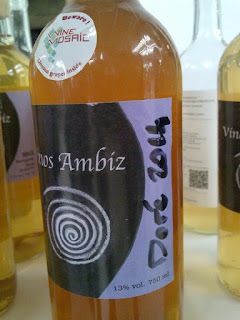Our RAW 2015 was decidedly a disaster but even so we found some treasures. Far fewer than if we had allotted the whole day instead of 2 hours and if we had done a bit of preparation. To cap it all our mobile decided to play Silly Buggers and conked out near the start only to relent and start up again just as we were leaving.
 |
| the range of Ambiz wines in fuzzy bottles |
So for the purposes of this blog we need to crave indulgence for the even worse standard of photography than usual and reliance on more post-production stuff than we would have preferred. Apologies too to the RAW Fair which produced an even better show than ever.
Our first major discovery were the wines of Fabio Bartolomei who has created Vinos Ambiz in Sierra de Gredos west of Madrid. Fabio is a humorous Italian Glaswegian living in Madrid; a translator by profession. He acquired an abandoned vineyard after the owners had gone bankrupt and produces only a fraction of its capacity seeming by himself. Yet that fraction includes some seriously interesting grape varieties hitherto unknown to Slotovino and made in the most natural of natural ways.
 |
| Fabio Bartolomei (centre) |
Indeed the wines are so natural as to preserve completely their essential character or funkiness in some cases. Funky wines are not for everyone but we like them. Increasingly an old grape variety is re-discovered only for producers to dumb down its individuality. Take Ortrugo for example, a highly individual grape making marvellously different wines. We have met some Ortrugos lately though that are masquerading as Prosecco. Peccato!
 |
| Dore |
 |
| Malvar |
|
|
|
Who has heard of Dore and Malvar? Certainly not us. These wines offered amazing taste sensations like nothing you have ever experienced. Fabio also produces monovarial wins from Airen, Albillo, Chelva (aka. Montuo/Montua), Sauvignon Blanc, Tempranillo and Garnacha. He is a real original. He writes a fantastic Blog too. Check it out!
We were delighted to see the California classic Natural Wine producer Ambyth next door. We had never seen these wines in Europe and hope they and other 7 - percenters such as Forlorn Hope will soon be widely available here as they deserve to be. Dirty and Rowdy have led the way so there is hope. Ambyth means 'Forever' in Welsh as you knew.
Wines on show included
Revera (Mourvedre, Grenache, Syrah and Counoise)
Venustas (Sangiovese, Tempranillo - aka. Malvasia Nera)
Priscus Aphora (Grenache Blanc, Marsanne, Viognier, Rousanne).
Marsanne Amphora
So plenty of diversity here. Hand up who knew that Tempranillo was Malvasia Nera! We didn't but now we do.
At about this point our Blackberry crashed so until it decided to come back to life at an appropriate moment near the end of our visit, we were reduced to going round without the essential photographic aide-memoire.
Great to find Cullen, Shobrook, Sedella Mountain Wines, Oszkar Maurer (as part of a collective set up by That Mad Frenchwoman, founder and director of RAW - respect!), wineries from the Czeh Republic (Moravia), Slovakia, Poland, Foradori, Cinque Campi (where we tasted theit Malbo Gentile as we had last year - still lovely),
It was pretty astonishing to find not one but two producers from the Garfagnana. We know of only four producers in all from this area. The Garfagnana, previously an independent state, now part of Tuscany is known as 'un niente' as far as wine is concerned but there are totally unknown grapes there including Balsoina, Verdolino, Farinella and Pighetta. That is more varieties than are native to some continents.
At the Azienda Agricola Macea stand we met Cipriano Barsanti, the non-flute playing brother of this family enterprise near Borgo a Mozzano in the province of Lucca. We have previously remarked on the incredible pyramid hill in this property where unusual varieties include Bracciola, Montanina and something called Tanne or Tannet which Cipriano assured us was not Tannat. The wine was quite interesting in a dry and tannic kind of way.
The other Garfagnana producer at the RAW fair was Podere Concori. Their Melograno is mostly Syrah with 'una piccola percentuale di vecchi vitigni.' We'd love to know what those are but meanwhile on first tasting, they didn't give the wine particular individuality, pleasant though it was.
One of the highlights of our visit was to find Arianna from Podere Scurtarola there with the Lorieri Vermentino Nero on show. Adrianna had been kind enough not only to give us a thorough tour of Scurtarola between Massa and Carrara last March but to pick us up at Macdonalds and take us back there again.
On that occasion we met Sra. Lorieri but not the great man himself. Here at RAW we finally had that great pleasure - only for a moment as he is a busy world-figure in the wine world. Nonetheless, his charming twinkling expression radiated from him and his thanks for mentioning him in our inconsequential Blog was completely sincere. We look forward to catching up with him on another occasion as we are sure we will. Just a pity we couldn't record the moment on our blasted mobile.
Then Cornelissen, Gauby, something called Collectif Anonyme whose name we liked, Georgians in strength, Astrians, Swiss, Slovenes but no Germans this year.
Passing by one of the Italian stands (this one devoted to a Lazio property) our glance was intercepted by a person we later learned to be Marco Marrocco. Marco asked us if we might be interested to taste his wines. We asked what 'uvaggio' they consisted of and when he said several, we thought to call his bluff and asked if any might be Uva Buona di Cori - a Lazio grape we had thoroughly enjoyed in the past but were unable to find since.
Marco didn't quite understand what we meant but proceeded to name the grapes from which his wines were made:
Capolongo, Maturano and Pampanaro for the whites
Lecinaro, Maturano Nero and Olivella (aka. Sciascinoso) for the reds.
Immediately our rare-grape radar started buzzing. The buzz was so strong that our mobile suddenly burst into life and obliged us with photos of Marco and his wines and others left for us to discover in the short time left. This was incredible. Totally unknown grapes from Lazio; an area normally dismissed as boasting only Cesanese and some more or less interesting Malvasias, together with the Uva Buona di Cori if you are a clever-socks like us.
Ever suspicious we assumed that some (most?) of these were probably synonyms for well known grapes such as Aglianico or Sangiovese but not at all; they are bona fide natives. The wine was lovely and soft with savory vinous tastes. Alcohol levels are low - 12% and 12.5% for the reds and 12% and 13% for the whites.
Marco took over Palazzo Tronconi only a few years ago. The story is a lovely one worth reproducing from Marco's excellent website www.palazzotronconi.com if he doesn't mind;
This is the story of a vineyard, owned by generations of a family,
sold on by the grandfather, Salvatore, only to be bought back years
later by the grandson. Six years ago Marco Marrocco set out to buy back
two and a half hectares of land. Land that was once carpeted in vines,
where his childhood was spent and where his heart remained.
At 37 and already a fully qualified engineer, Marco returned to the
University of Tuscia and gained an AIS Diploma (The Association for
Sommeliers in Italy), followed by a degree in Oenology. His years of
study took him into the region of Bordeaux where he worked alongside the
great Daniel Mouty, fourth generation vineyard owner of Chateau du
Barry, Saint-Emilion, Grand Cru, Chateau Grand and Beauséjour Pomerol.
With the guidance of Gaetano Ciolfi, Professor of Enology and Simone
Noro, son of horticulturist Carlo Noro, leading expert on biodynamics in
Europe, Marco set to work to replant a new vineyard. The soul of the
vineyard was reborn and with it a new chapter involving the principles
of biodynamic agriculture.
Marco re-discovered abandoned, ancient vines that were historically
grown in Arce. Red grape – Lecinaro; white grape -Capolongo, Pampanaro
and white Maturano. Also the red grape Maturano, still the subject of
research at the centre of Enology along with the red grape Olivella.
There is more; go to the website!
These wines will take the world by storm Slotovino predicts.
Flush with success, we made it over to the English producers where there were other wonderful surprises.
The first was a new one on us: Charlie Herring. This is an operation producing wine in very small quantities. Why? Because they are planted in a walled garden. This makes it possible to grow Sauvugnon Blanc and ripen it convincingly.
Chardonnay is also grown and there is an interesting Partnership deal in which you can own a small portion of the vineyard and receive a few bottles every year. On this showing, the wine is worth it.
Next we met Will Davenport himself of Davenport Vineyards (Limney and Horsmonden). Will is one of the giants of the UK wine scene, producing miraculously good organic wines from the unpromising Seyval Blanc grape for a start. He was thoroughly amiable and seemed genuinely surprised to hear his Sparkling Wine is available in Budgen's (Thorntons).
Organic producers in the UK are few and far between so it was a further pleasure to discover Albury Organic Vineyards from the evocatively-named Surrey Hills (a district of Sydney). His vines look lovely and healthy in their publicity photo.
Next year we promise;
1. Get a new mobile phone and take a camera as well in case of a breakdown
2. Spend an entire day instead of half an afternoon.
3. Get the catalogue well in advance and prepare thoroughly
We can never know how many interesting wines and vignerons we have missed.














































